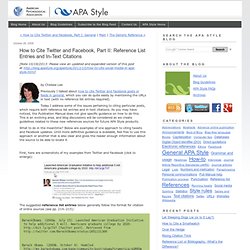

APA 6th Edition PPTS. APA Formatting and Style Guide. Summary: APA (American Psychological Association) style is most commonly used to cite sources within the social sciences.

This resource, revised according to the 6th edition, second printing of the APA manual, offers examples for the general format of APA research papers, in-text citations, endnotes/footnotes, and the reference page. For more information, please consult the Publication Manual of the American Psychological Association, (6th ed., 2nd printing).
Contributors: Joshua M. Paiz, Elizabeth Angeli, Jodi Wagner, Elena Lawrick, Kristen Moore, Michael Anderson, Lars Soderlund, Allen Brizee, Russell KeckLast Edited: 2018-02-21 02:26:13 Please use the example at the bottom of this page to cite the Purdue OWL in APA. To see a side-by-side comparison of the three most widely used citation styles, including a chart of all APA citation guidelines, see the Citation Style Chart. You can also watch our APA vidcast series on the Purdue OWL YouTube Channel. General APA Guidelines Title Page Abstract. Hacker-Mira-APA-2010.pdf. Avoiding Plagiarism and Lazy Writing. Students are often confused about how to use materials from sources (e. g., journals and books) that they read.

Too often material is used inappropriately, in most cases because a student may not know how to properly use such material. The information on this page will help you to avoid two serious flaws in writing plagiarism and lazy writing . What is Plagiarism? Plagiarism occurs when you use someone else's words or ideas from a copyrighted source. Whenever something is fixed in some medium (for example, a book, journal, electronic storage medium, or even a term paper written by a fellow student) the work is automatically copyrighted.
When most students think of plagiarism they think of using someone else's words or ideas without properly citing the source. The dynamic nature of human memory suggests that information in memory can be influenced by a variety of factors. The dynamic character of human memory suggests that information stored in memory can be acted upon by many factors. Paraphrase Exercises. Avoid Plagiarism: Quoting, Paraphrasing, and Summarizing. Good writing takes time.

This means that students need to set time aside to brainstorm, pre write, plan, draft, and then revise, revise, and revise. If students leave their essay to the last minute, they tend to become overwhelmed by the writing task and panic by looking for an alternative. This alternative is usually plagiarism. Students must do everything possible to avoid plagiarism. Plagiarism, a form of academic misconduct, results in failure. Students should feel comfortable browsing the internet in search of information related to their essay topic. 1) Print everything! 2) Photocopy everything! Author—Creator or compiler of the information; for web sites this may be the Webmaster or the owning organization. Quoting, Paraphrasing, & Summarizing: Why use quotations, paraphrases, and summaries? Finally, you should rotate use of all three methods to add stylistic variety to your paper.
Some examples to compare… Intertwining all Three in a Body Paragraph... 1. Sample Note Card: EasyBib: Free Bibliography Generator - MLA, APA, Chicago citation styles. APA: How to Cite Twitter and Facebook, Part II: Reference List Entries and In-Text Citations. [Note 10/18/2013: Please view an updated and expanded version of this post at by Chelsea Lee Previously I talked about how to cite Twitter and Facebook posts or feeds in general, which you can do quite easily by mentioning the URLs in text (with no reference list entries required).

Today I address some of the issues pertaining to citing particular posts, which require both reference list entries and in-text citations. As you may have noticed, the Publication Manual does not give specific guidance on how to do this. This is an evolving area, and blog discussions will be considered as we create guidelines related to these new references sources for future APA Style products. What to do in the meantime? First, here are screenshots of my examples from Twitter and Facebook (click to enlarge): The suggested reference list entries below generally follow the format for citation of online sources (see pp. 214–215): Here’s the rationale I used for presenting each element in the reference: What’s Next.